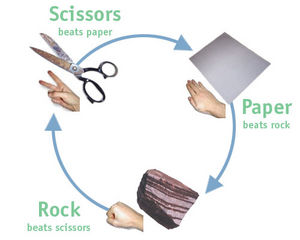Game theory: Decision making with mindreading
In game theory, the rationality of expected utility theory is applied to situations where the outcomes of the choices you make are affected by the decisions and outcomes of other people’s choices. Strategic interactions of this sort can be called ‘games’ where within which your job is to make rational ‘moves’, given the information you are provided with.
The rock-paper-scissors hand game we have all played gives you a flavour of what is involved in the process of trying to double-guess the decisions of the player you are interacting with.

.
Good players know how to exploit patterns of choices in their opponents, effectively ‘mind-reading’ the decisions of others to their own advantage.
The Prisoner’s Dilemma
Your HighIQPro problem is a classic formulation of the prisoner’s dilemma. What did you decide to do? Remember that the offer you are given is given independently to your accomplice – There is no way for you to know what he decides to do before you make up your mind on what you will do.
Remember – HOW you represent a problem can help greatly in solving a problem. Here is a useful way of representing the decisions and outcomes – in a matrix.
.
The assumption is that you and the other prisoner are rational. You want to have the shortest prison sentence possible. Since you cannot know what your accomplice will do, one way of solving this decision-making problem is to use our working memory for some System 2 analysis of consequences, using a ‘tree’ format to represent the problem.
If you are silent he could do one of two things – be silent or testify, resulting in either a 1 month or 1 year sentence for you.

.
If you confess (betray) the other prisoner, he could do one of two things – be silent or betray you, resulting in either going free or a 3 month sentence for you.
.

.
When you compare the outcomes of your two options, you can see clearly now how it is more rational for you to confess/betray. The worst that could happen to you is 3 months (vs 1 year) and the best that could happen to you is to go free (vs 1 month).
Of course, the trouble is that since the other prisoner is also rational, he will also choose to confess. The result is that you will both serve three months in jail.
This is a frustrating outcome, because if you had opted to both cooperate with each other and remain silent, you would have both had a better outcome (only 1 month jail each).
.
Repeated (Iterative) Prisoner’s Dilemma
Now what strategy or strategies should you adopt if you repeatedly end up with the same person with the same payoffs? If you always betray, your opponent is likely to always betray, and this is not an optimal long-term outcome. But if you both converge on remaining silent (cooperating), research shows that end up with the better long-term outcome.
The strategy that is very successful in this kind of iterative scenario is to is to cooperate (remain silent) on the first iteration of the game; after that, the player does what his or her opponent did on the previous move, in a ‘tit for tat’ way – punishing times when your partner acts ‘selfishly’ by betraying you, while rewarding cooperation with cooperation.
Further reading
In their best-selling book, The Art of Strategy: A Game Theorist’s Guide to Success in Business and Life K. Dixit and Barry J. Nalebuff share the ways that game strategy can help in attaining successful outcomes.
You may have heard of game theory by watching Russell Crowe in the 2001 movie “A Beautiful Mind” which was inspired by the life of John Forbes Nash, a Nobel Laureate in Economics.



No comments yet.